
Suspended Animation #408
The Ruby-Spears animation studio was founded in 1977 as a subsidiary of Filmways by writers Joe Ruby and Ken Spears who had created Scooby-Doo Where Are You? for Hanna-Barbera. It closed in 1996. Ruby and Spears died in 2022 within three months of each other.
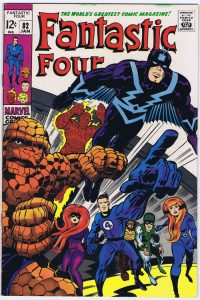 From roughly 1980 to 1986, Jack Kirby known for his iconic comic book characters like Captain America worked at the studio. In 1976 Kirby had returned to Marvel Comics after a brief five year stint at DC Comics but was tired and wanted to get out of the comic book business.
From roughly 1980 to 1986, Jack Kirby known for his iconic comic book characters like Captain America worked at the studio. In 1976 Kirby had returned to Marvel Comics after a brief five year stint at DC Comics but was tired and wanted to get out of the comic book business.
Marvel had licensed the rights to their Fantastic Four comic book co-created by Kirby and Stan Lee to DePatie-Freleng Studio for a Saturday morning animated cartoon series. Writer Mark Evanier called the animation director of the series to remind him that Kirby was now located in California and was available.
Kirby agreed to work on the series because Marvel had agreed that the work would count toward the number of pages still required under his contract before he could leave the company and it took him away with having to deal with Marvel executives in New York.
Kirby was given no direction on how to do a storyboard other than it was “like a comic strip” so while the work he did was terrific, it was for the most part unsuitable as an animation storyboard that required sparse action (to save money) and more dialog.
In fact, without Kirby’s knowledge, Marvel took the storyboard that Kirby had done for the episode of the Fantastic Four meeting Dr. Doom for the first time and had a variety of inkers finish the pencil artwork and published it as a fourteen page story in Fantastic Four #236 (1981) to celebrate the 20th anniversary of the title.
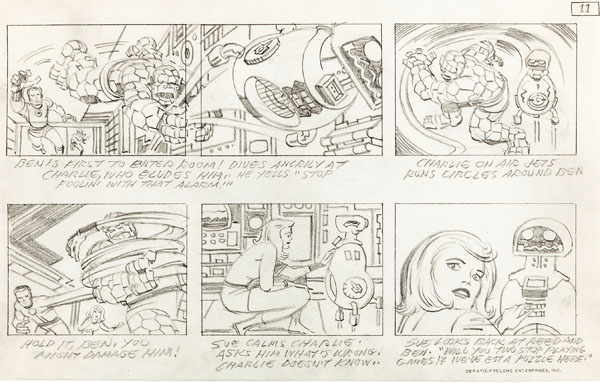
Writer Steve Gerber had pitched an adventure series to Ruby-Spears called Thundarr the Barbarian and the studio had Alex Toth design the three main characters: The muscular former slave Thundarr who accompanied by his friends Ariel, a female sorceress, and Ookla the Mok an animal hybrid like Chewbacca fight injustice.
The premise for the series was that in the post-apocalyptic wasteland of Earth in the year 3994, the different kingdoms and territories were ruled by wizards in a landscape that featured recognizable geographic features like Las Vegas, Mount Rushmore, San Francisco, Grand Canyon and more.
ABC was a little unsure about the show and since Toth was unavailable at the moment, Joe Ruby hired Jack Kirby who did several big pieces of artwork inked by Alfredo Alcala (although Kirby’s wife Roz inked one or two). Ruby later claimed it was Kirby’s artwork that sold the show and he put the artist under contract.

At first, Kirby once again tried doing storyboards but they were mostly unusable. He found his niche doing concept ideas, character and prop designs including vehicles. He was put on a contract to receive a certain dollar figure per week for drawing new ideas. When things were slow he was loaned out to Hanna-Barbera on The All New Scooby and Scrappy Doo Show, Super Friends: The Legendary Super Powers Show and the Space Ghost episodes of Space Stars.
There were hopes that Thundarr would be a huge success and Kirby penciled samples for two weeks worth of dailies and Sundays for a newspaper strip. The show was constantly moved around being a victim to the fall sports schedule so it never built up an audience and was cancelled after 21 episodes.
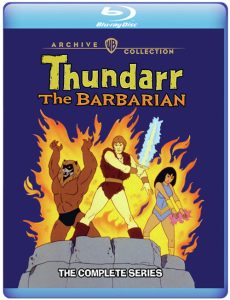 Kirby was happier than he had been in years. Not only was he given a great salary and a health plan (that came in valuably later when he had a heart attack that would have wiped out everything he had without insurance) but he was surrounded by people who respected him and loved hearing him tell stories about growing up rough in Brooklyn and his experiences serving during World War II. He would even join in with their makeshift band playing a guitar or a trumpet.
Kirby was happier than he had been in years. Not only was he given a great salary and a health plan (that came in valuably later when he had a heart attack that would have wiped out everything he had without insurance) but he was surrounded by people who respected him and loved hearing him tell stories about growing up rough in Brooklyn and his experiences serving during World War II. He would even join in with their makeshift band playing a guitar or a trumpet.
Joe Ruby loved Kirby and the two would sometimes sit around smoking cigars and telling stories. Ken Spears was unsure why they were paying Kirby so much but Ruby told him that Kirby was more than worth it and Spears later realized he was right.
In addition, Kirby could draw on large scale boards which was a benefit because he was having trouble with his vision. In fact, he was no longer allowed to drive and his wife Roz chauffeured him to the studio. In addition, Kirby found with his new schedule he could spend more time with his grandchildren.
Jim Woodring who among other things inked and water colored some of the boards that Kirby brought in recalled, “It was his job to come up with ideas that might be turned into TV shows. So he would come in every Monday morning with a big thick stack of 20” x 30” Crescent board under his arm, on which he had drawn characters, settings, and show ideas.
“He had given names to all the shows, all the characters and vehicles, which were all really imaginative.”
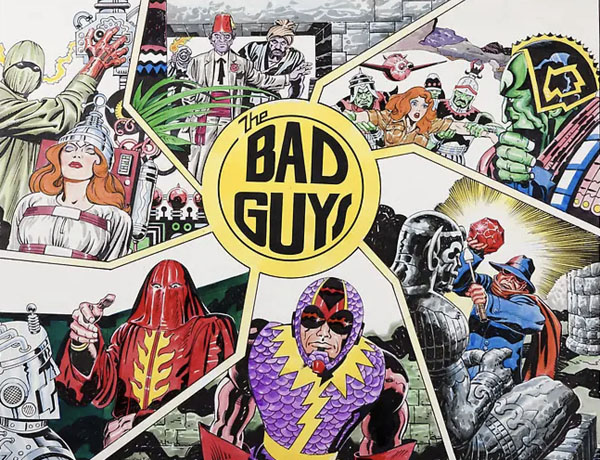
After Thundarr, Kirby worked on Goldie Gold and Action Jack also conceived by Gerber about a beautiful young newspaper heiress with Richie Rich-type wealth and her bodyguard/photographer Jack Travis who sought out adventure and intrigue.
Kirby went on to work on Ruby-Spears series including Turbo Teen, Centurions: Power XTreme, Rambo, Sectaurs, Chuck Norris’ Karate Kommandos and Lazer Tag Academy.
However, his true Ruby-Spears legacy might be all the unsold concepts that he developed in addition to shows that Ruby had him create pitch boards for series that never sold or were produced including one for the KISS musical group and another for Planet of the Apes.
Kirby did a pitch board for Lee Falk’s The Phantom inked by Mike Royer where he suggested and illustrated several ideas including “villains turn a vibration weapon on the Phantom’s jungle cave to gain entrance to his fabulous treasure room; a sorcerer seeking spells among the Phantom’s books in his ancestor’s library releases evil spirits; The Phantom protects two teenagers against a hostile clone patterned in his own image; huge robots are programmed to break into the Phantom’s cave throne room and the Phantom finds a strange tunnel that leads to a hidden prehistoric kingdom.”
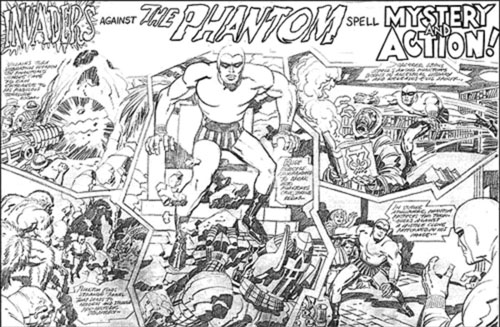
Among Kirby’s original concepts were the Warriors of Illusion (an alliance of magicians set in a world of escape artists, sorcerers and more), Roxie’s Raiders (a riff on Indiana Jones and set in the 1930s to be done in cliff-hanging chapters developed with writer Steve Gerber about redheaded Roxie who is an adventuress and spy and runs a traveling circus of characters that look like they might come from a Freak Show), and Animal Hospital that was a slightly risque and cartoony soap opera of talking animals at a hospital for a late night time slot.
Micro Mites (a team of four tiny superheroes molded in the lab from living clay who could fit in the palm of your hand), Golden Shield (a supernatural Incan warrior taking on Invaders from another dimension), Banzai Express (stunt men and women who will deliver anything anywhere for the right price), The Gargoids (scientists who gain powers but whose bodies are misformed after being infected by an alien virus), and Power Planet (Tiger Shark. Captain Lightning, Four Arms, Crusher, Metaltum and Lava Man… each sector of the planet broken by a meteor from outer space must send a superhero to form a force to battle the villains who caused the cataclysmic event).
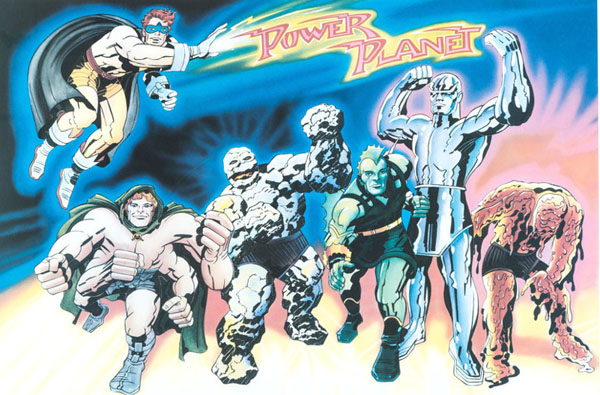
Kirby was employed under a work-for-hire agreement, which means that his work was the property of the studio. At one point Spears was going to throw out all of the artwork to save on storage costs but Ruby insisted they would be worth something someday.
When in 2010 Ruby and Spears were negotiating with Sid and Marty Krofft to develop some of Kirby’s concepts, Spears said, “Basically, the beauty of the whole thing is that a lot of Jack’s stuff did not have a time set behind it. A lot of the things he did for us were things he did on his own. Even when he was doing a specific project for us, where we had an origin story developed for that direction and he would come up with the creative direction of what they looked like, he would do things on his own.”
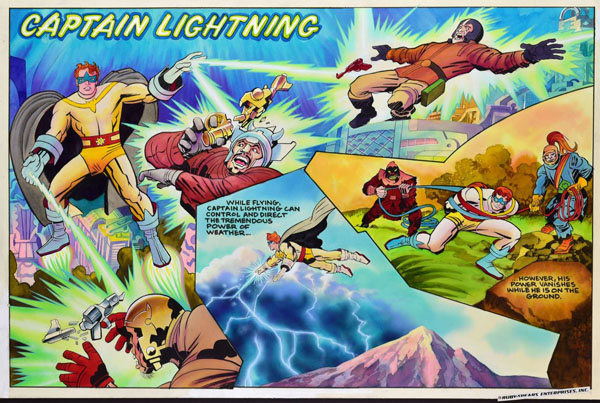
Of the hundreds of animation concepts that Kirby did for Ruby-Spears, ninety of them were issued in a full color trading card set from Comic Images in 1994 under the title Jack Kirby The Unpublished Archives. Some of the artwork is by Doug Wildey and Gil Kane re-doing Kirby’s initial concept that was sometimes done at Ruby Spears.
Today, the owners of the artwork are trying to sell Kirby’s Ruby-Spears art as NFTs.
Towards the end of his time at Ruby-Spears, Kirby was frustrated that his concepts weren’t being produced. That anger can be seen in some of his last work like a drawing of a character named Heidi Hogan, a bearded lumberjack in a pinafore dress jumping off a cliff while wearing a propeller beanie.
However, Kirby’s time at Ruby-Spears provided him financial and medical security and allowed him to explore endless concepts including humor. Refreshed by his experience at the animation studio, King Kirby went on from there to new adventures.


 Jim Korkis is an internationally respected animation historian who in recent years has devoted his attention to the many worlds of Disney. He was a columnist for a variety of animation magazines. With his former writing partner, John Cawley, he authored several animation related books including The Encyclopedia of Cartoon Superstars, How to Create Animation, Cartoon Confidential and Get Animated’s Animation Art Buyer’s Guide. He taught animation classes at the Disney Institute in Florida as well as instructing classes on acting and animation history for Disney Feature Animation: Florida.
Jim Korkis is an internationally respected animation historian who in recent years has devoted his attention to the many worlds of Disney. He was a columnist for a variety of animation magazines. With his former writing partner, John Cawley, he authored several animation related books including The Encyclopedia of Cartoon Superstars, How to Create Animation, Cartoon Confidential and Get Animated’s Animation Art Buyer’s Guide. He taught animation classes at the Disney Institute in Florida as well as instructing classes on acting and animation history for Disney Feature Animation: Florida.




















































I used to think Thundarr was the least interesting thing Steve Gerber ever came up with, but after re-watching and comparing it to other action cartoons of the time, it holds up pretty well.
I had no idea Jim Woodring ever worked for them, or in animation at all. For him to credit something as being imaginative is saying something.
I saw Jack Kirby coming out of the Oak Crest Grocery around the time of Thunder (up the street from Ruby & Spears and across and down the street from Hanna-Barbera. He shook my hand and commented “I created all those Goddamn characters Stan Lee takes credit for!”
It’s funny how Kirby was always consistent and emphatic about being the sole creator of the Marvel characters despite whatever Mark Evanier likes to say on his blog
much as I would want to respect Ruby Spears and their efforts to capitalise on such material, at least 2 of the properties foremost in their YouTube pitch are clearly the work of Gil Kane and not Jack Kirby, and that they don’t themselves make any distinction does a considerable disservice to the legacies all concerned
Joe and Ken have been dead for a couple years so this is whoever bought the rights to the company’s name
I believe the sons, Craig Ruby and Kevin Spears own that artwork, now- maybe they’ll consider assembling a team to utilize the leftover artwork, themselves. Keep in mind, they’re a family of animators and have connections, especially to Allen Bohbot’s 41 Entertainment. There’s still Jack Kirby’s daughter, Lisa as well as Michael Wahl, late of Gunther-Wahl Productions Inc.- they can work with Craig and Kevin. They just need to get together and discuss utilizing the artworks, themselves. Craig and Kevin can also talk to Krofft family, too- their fathers worked with Sid and Marty Krofft. If they can’t sell the artwork, they can utilize it, themselves- they have the resources and the personnel to do so as well as all kinds of connections!!!
Real cool. Had no idea The King worked in animation!
Kirby also worked as an in-betweener at Fleischer when he was in his late teens.
And the moral is that you have the choice: working for peanuts in something that changes the history of your medium or got some money and medical care doing stuff aimed to be shelved while you wait your next heartattck.
Great story, anyway.
Being a huge fan of Jack Kirby I appreciated and enjoyed that presentation info on the collaboration of Jack Kirby & Ruby-Spears it was very interesting things I wasn’t aware of on their animation work thank you for sharing your knowledge of of these things with a fan!
MAN, I LOVED THUNDARR WHEN I WAS KID! Definitely need to check it out again. Thanks for this article.
I am still wondering. Who originated the idea about “Skysurfer Strike Force”? And will you please elaborate on about this show in the next article?
Power Planet obviously borrowed character models from the Fantastic Four. The Silver Surfer, The Thing and Triton, just to name a few. I wonder if it was going to be a Marvel Comics cartoon?